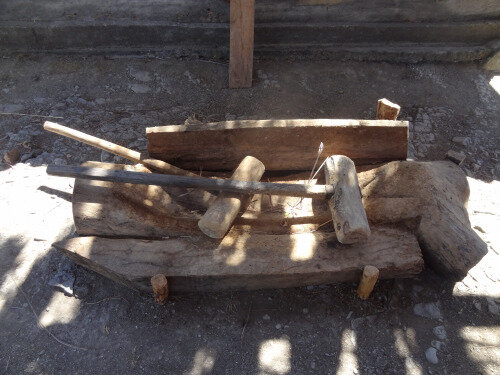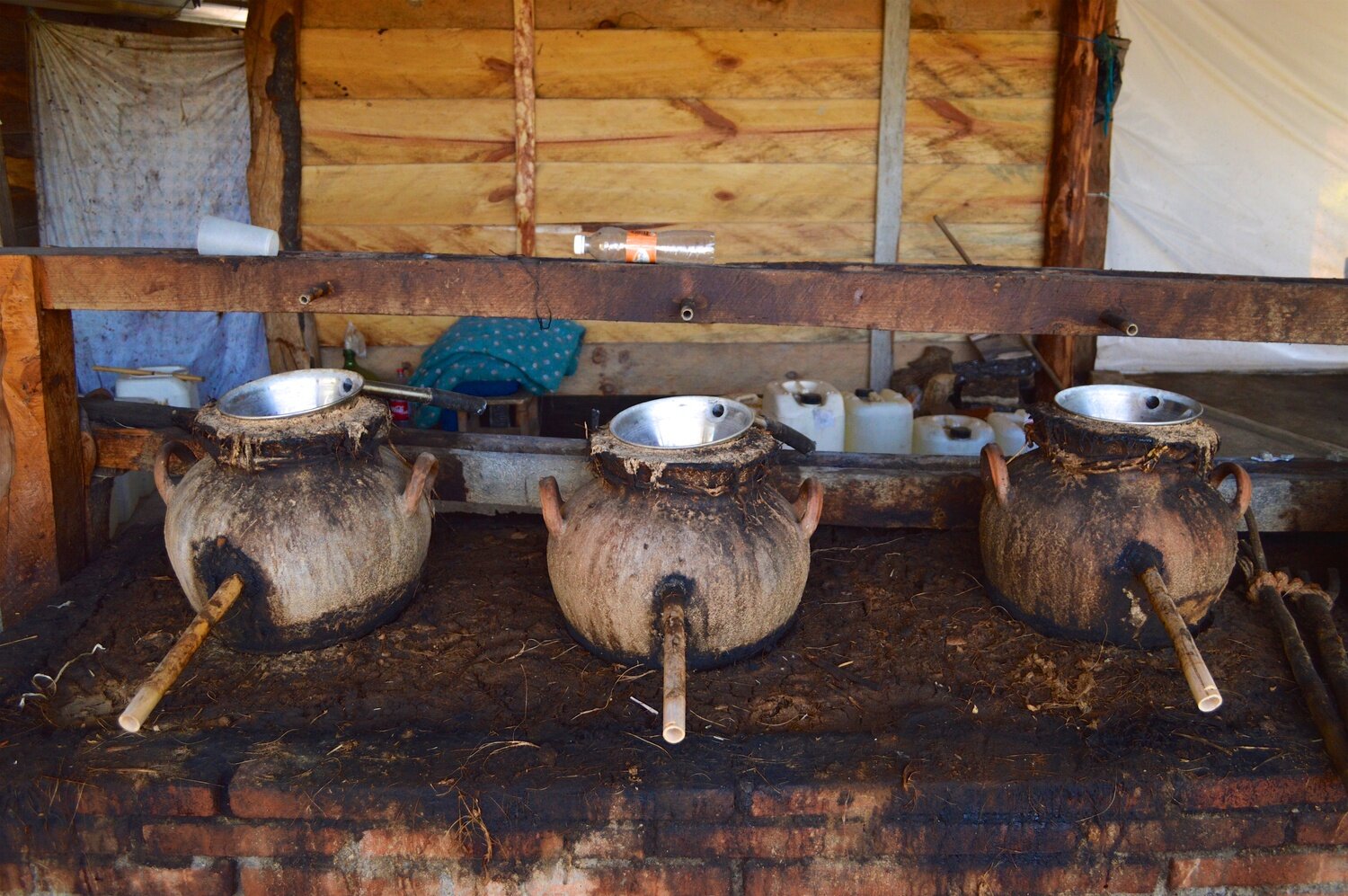Barril en Barro Batch S-18-B-19
NEW! RELEASE! ALERT!…. NEW! RELEASE! ALERT!
It has certainly been a minute since we did a special release for our good friends in California. In an effort to make up for it, we waited for something truly special, and undoubtedly, this 100% Barril en Barro from Tío Rey fits that bill. Produced in the fall of 2019, this new expression for Tío Rey was produced from what we typically would recognize as cultivated Madre Cuixe. At only 245 liters, this entire 50-case batch is currently landing on shelves and back bars in the Golden State. It is sure to be a bright spot in the summer sipping season.
This new batch consisted of 40 piñas, weighing 1,814 kg. They were harvested on October 5th, 2019, from the area surrounding Tío Rey’s palenque in Gulerá, Sola de Vega. They were roasted underground for four days between October 12th and 16th before being milled by hand on October 16th and 17th. After milling, the batch yielded 1,751 liters of ground agave, to which Tío Rey added 327 liters of fresh spring water. The 2,078 liters of tepache fermented for 7 days before being distilled in Tío Rey’s 45-liter clay pot stills, which were handcrafted in Santa Maria Atzompa. The first distillation yielded 430 liters of xixe at 22% ABV, with second distillation yielding 245 liters of mezcal at 47.9% ABV.
Agave Barril/Madre Cuixe (a. Karwinskii)
Agave Madrecuixe is one of several varieties of the Agave Karwinskii family. These agaves typically grow on stalks that can reach up to 4 feet tall with the rosette or piña growing on top of the stalk, resulting in a plant that can reach heights of up to 7 feet. Agave in the Karwinskii family can often take between 15 and 18 years to mature.
Between the several different sub-varieties of Karwinskii, there are different ratios of stalk to piña which can affect the final flavor. The starches in the stalk are structured differently, such that they do not always break down during the roasting process. As a result, in sub-varieties like Cuixe that have more stalk in relation to the piña, this can result in mezcales that do have a core of agave sweetness that most are used to, but there is an overall dry and starchy quality to the mezcales that can linger on the palate. Madrecuixe typically has a larger piña than Cuixe, resulting in mezcales that do have that starchy, grassy note often associated with Cuixe, but with a touch more sweetness and body. One reason that Madrecuixe is so named is that they often grow as solitary plants surrounded by several Cuixe, as though they are protecting, or a “mother” (madre) plant. However, the Cuixe are not part of the Madrecuixe.
The distribution of Agave Karwinskii can be seen in the map below.
*Image taken from CONABIO website.
Producer: Salomón Rey Rodriguez
Location: Sola de Vega, Oaxaca
The palenque and agave fields of Salomón Rey Rodriguez or “Tío Rey” (Uncle Rey) are located in the famous mezcal region Sola de Vega. The mezcaleros in this region distill mezcal almost exclusively using clay pots called “Olla de Barro”.
Tío Rey’s town of Gulerá is about 15 minutes up the valley and is part of the municipality Villas Sola de Vega. The lush mountain valley is a 2.5-hour drive from Oaxaca and sits at 1450 M above sea level.
Tío Rey has a great supply of spring water that flows year round and contributes to the unique flavor of his mezcals. The mineral-rich soil and relatively cooler climate make for a perfect spot for growing a variety of agaves. Salomón Rey has at least 15 varieties of agave that he cultivates, including Espadín, Coyote, Arroqueño, Mexicano, Tobalá, Sierra Negra, Madre Cuixe, Blanco, and Barril.
Sola de Vega agave maturation times:
Espadín - 7 -12 years
Mexicano - 7- 12 years
Arroqueño - 9 - 25 years
Coyote - 5 - 10 years
Sierra Negra 10 -25 Years
Tobalá - 8 - 18 Years
The palenque (distillery) is at Tío Rey’s ranch where he lives full time with his family. He built it approximately 10 years ago from parts of an older palenque that was his fathers. It moved around from nearby locations over the years. The lineage of mezcaleros in Tío Rey’s family could arguably go back thousands of years. They emigrated from the Miahuatlán region over 100 years ago due to Zapatista activity during the Mexican Revolution.
Tío Rey has never produced mezcal commercially before Mezcal Vago and produces exclusively for Mezcal Vago.
Tío Rey’s batch sizes are generally from 100 liters to 450 liters. He has two classic earthen ovens that can each hold around three tons. One oven is the normal dug out hole in the ground and lined with large river rocks and the other is dug straight into bedrock. He roasts each batch for 2 to 3 days.
The cooked agave is hand ground with wooden mallets called canoas y mazos. The roasted piñas are chopped slightly with a machete then the pieces are placed on a wooden platform and pounded with the mallets. An incredibly laborious technique but they are sure the flavor is better this way when not molested by such modern technology as a cement wheel and horse!
Tío Rey has four fermentation vats. Three are typical vats, cylindrical and made from pine. Two have a capacity of 1,200 liters and the third holds 900 liters. The fourth is made from the trunk of a large Pino Sabino (Pine tree) hollowed out in the shape of a canoe and has been in use for 90 years and holds about 900 liters!
For distillation, Tío Rey uses a series of clay pots. The clay pots are called “Olla de Barro” in Spanish. That is why Mezcal Vago refers to its mezcals that are distilled in this manner as “en Barro.” They hold about 45 liters each. Each pair of pots shares a fire. The stills are made of stacks of two pots. One that holds the mash (boiler) and has an open top, and another with an open bottom that rests on top of the first one (condenser). On the top pot there is an upside-down stainless steel bowl that water continually runs in and out of. When the heat from the mash rises and hits the cool top created by the water, condensation occurs. An agave leaf works as a large spoon to catch the dripping condensation (mezcal) and runs into a reed that flows the mezcal into the collection container.
This whole process is laborious and takes around 4 times the effort of a copper still and stone tahona method.
First Distillation
First distillation of a ~45 liter load of tepache takes about 3 - 4 hours and will produce about 8.5 liters of xixe that will have an ABV in the mid-20′s. The next 1.5 hours will produce ~1.5 liters of xixe that does not contain enough flavor to produce mezcal and will be redistilled later for other uses around the palenque.
Rectificación
A ~50 liter batch of xixe will undergo second distillation, or “rectificación” over a period of 5 - 6 hours total. The first 1-2 hours will produce about 2 liters of heads, or “puntas,” which range between ~65-70% ABV. The next 3-4 hours will produce about 15-20 liters of mezcal at a proof of ~40-65% ABV. The final 15 - 20 minutes will produce about ~2-3 liters of tails or “colas” that are roughly 30% ABV. The puntas and colas of the rectificación will be redistilled a third time to be used around the palenque. The containers of usable mezcal will be allowed to rest for a few days before being blended into one single homogeneous batch and then rested in stainless steel or glass. Tío Rey never adds water to his mezcal post-distillation. Cuts are made by taste and smell.
All of Tío Rey’s Mezcal go through a simple triple sediment filtration through tubular cellulose filters. The bottling is done by hand in the city of Oaxaca. The light filtration is the only way the mezcal is affected between how it was made on the palenque and how it ends up in the bottle.















